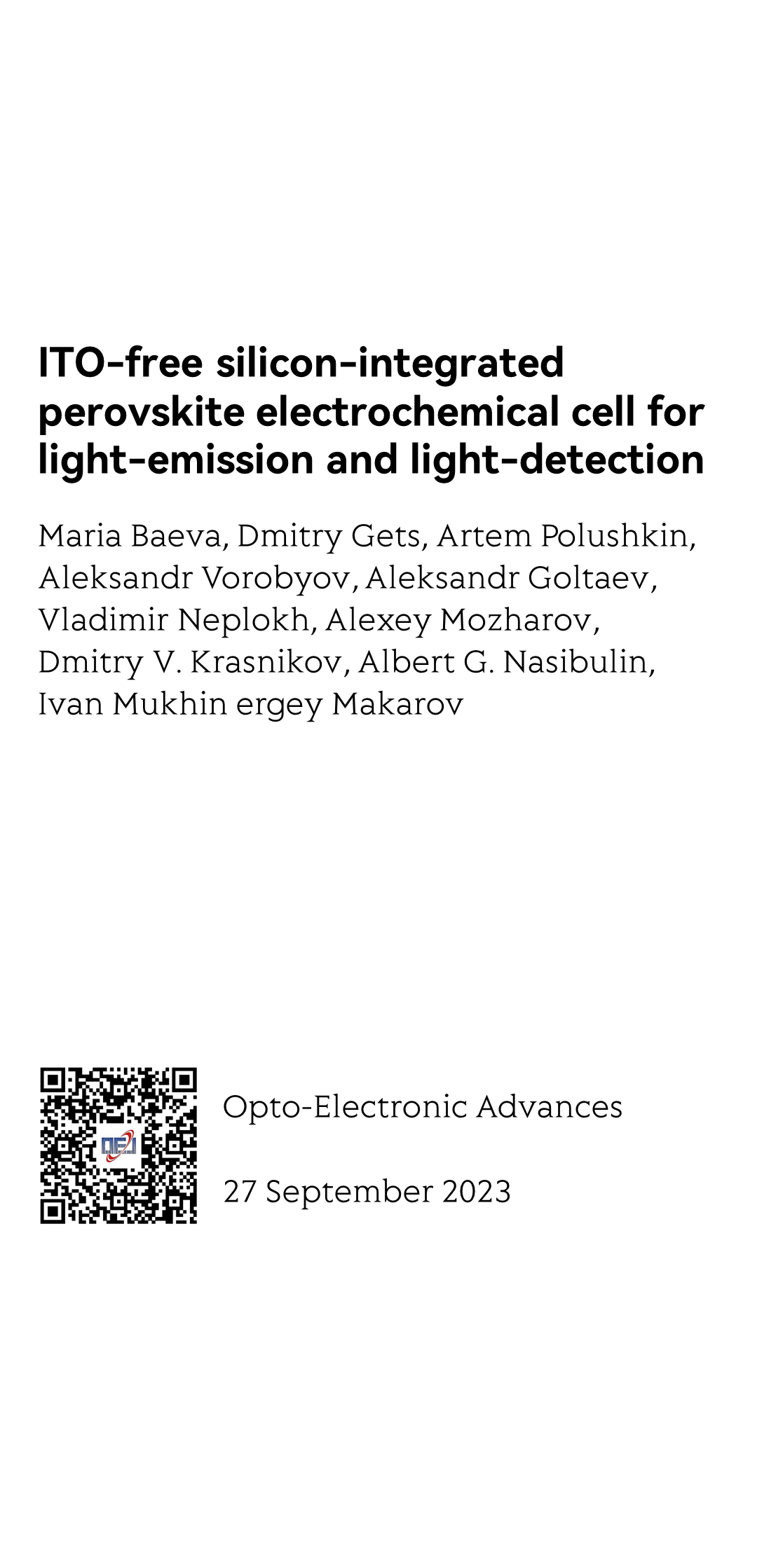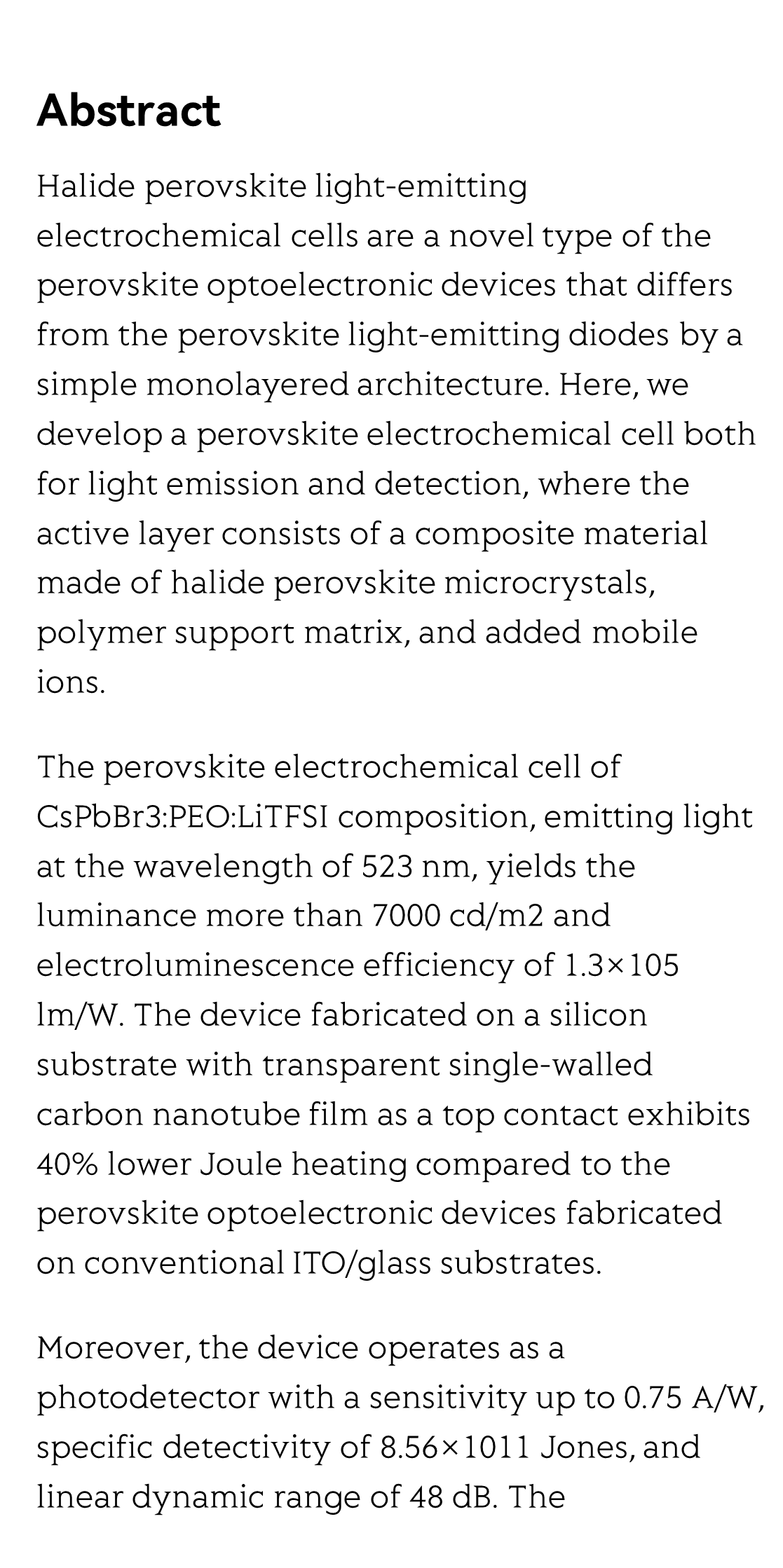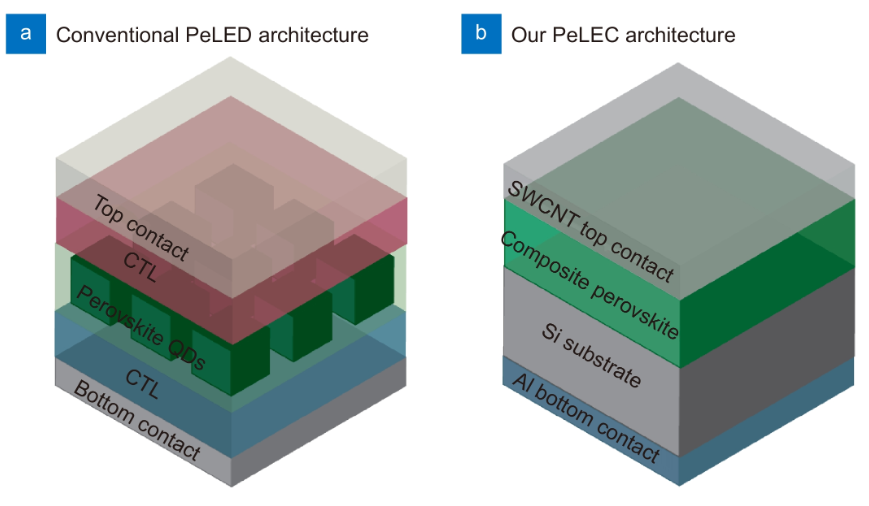(Peer-Reviewed) ITO-free silicon-integrated perovskite electrochemical cell for light-emission and light-detection
Maria Baeva ¹ ² ³, Dmitry Gets ², Artem Polushkin ², Aleksandr Vorobyov ¹, Aleksandr Goltaev ¹, Vladimir Neplokh ¹ ⁴, Alexey Mozharov ¹, Dmitry V. Krasnikov ⁵, Albert G. Nasibulin ⁵, Ivan Mukhin ¹ ⁴, Sergey Makarov ² ⁶
¹ Alferov University, Khlopina 8/3, St. Petersburg 194021, Russia
² Department of Physics and Engineering, ITMO University, Lomonosova 9, St. Petersburg 197101, Russia
³ Institute of Automation and Control Processes (IACP), Far Eastern Branch of Russian Academy of Sciences, Ulitsa Radio 5, Vladivostok 690041, Primorsky Krai, Russia
⁴ Peter the Great St. Petersburg Polytechnic University, Polytechnicheskaya 29, St. Petersburg 195251, Russia
⁵ Skolkovo Institute of Science and Technology, Nobel 3, Moscow 121205, Russia
⁶ Qingdao Innovation and Development Center, Harbin Engineering University, Qingdao 266000, China
中国 青岛 哈尔滨工程大学青岛创新发展基地
Opto-Electronic Advances
, 2023-09-27
Abstract
Halide perovskite light-emitting electrochemical cells are a novel type of the perovskite optoelectronic devices that differs from the perovskite light-emitting diodes by a simple monolayered architecture. Here, we develop a perovskite electrochemical cell both for light emission and detection, where the active layer consists of a composite material made of halide perovskite microcrystals, polymer support matrix, and added mobile ions.
The perovskite electrochemical cell of CsPbBr3:PEO:LiTFSI composition, emitting light at the wavelength of 523 nm, yields the luminance more than 7000 cd/m2 and electroluminescence efficiency of 1.3×105 lm/W. The device fabricated on a silicon substrate with transparent single-walled carbon nanotube film as a top contact exhibits 40% lower Joule heating compared to the perovskite optoelectronic devices fabricated on conventional ITO/glass substrates.
Moreover, the device operates as a photodetector with a sensitivity up to 0.75 A/W, specific detectivity of 8.56×1011 Jones, and linear dynamic range of 48 dB. The technological potential of such a device is proven by demonstration of 24-pixel indicator display as well as by successful device miniaturization by creation of electroluminescent images with the smallest features less than 50 μm.
Review for wireless communication technology based on digital encoding metasurfaces
Haojie Zhan, Manna Gu, Ying Tian, Huizhen Feng, Mingmin Zhu, Haomiao Zhou, Yongxing Jin, Ying Tang, Chenxia Li, Bo Fang, Zhi Hong, Xufeng Jing, Le Wang
Opto-Electronic Advances
2025-07-17
Multiphoton intravital microscopy in small animals of long-term mitochondrial dynamics based on super‐resolution radial fluctuations
Saeed Bohlooli Darian, Jeongmin Oh, Bjorn Paulson, Minju Cho, Globinna Kim, Eunyoung Tak, Inki Kim, Chan-Gi Pack, Jung-Man Namgoong, In-Jeoung Baek, Jun Ki Kim
Opto-Electronic Advances
2025-07-17
Non-volatile tunable multispectral compatible infrared camouflage based on the infrared radiation characteristics of Rosaceae plants
Xin Li, Xinye Liao, Junxiang Zeng, Zao Yi, Xin He, Jiagui Wu, Huan Chen, Zhaojian Zhang, Yang Yu, Zhengfu Zhang, Sha Huang, Junbo Yang
Opto-Electronic Advances
2025-07-09
CW laser damage of ceramics induced by air filament
Chuan Guo, Kai Li, Zelin Liu, Yuyang Chen, Junyang Xu, Zhou Li, Wenda Cui, Changqing Song, Cong Wang, Xianshi Jia, Ji'an Duan, Kai Han
Opto-Electronic Advances
2025-06-27
Operando monitoring of state of health for lithium battery via fiber optic ultrasound imaging system
Chen Geng, Wang Anqi, Zhang Yi, Zhang Fujun, Xu Dongchen, Liu Yueqi, Zhang Zhi, Yan Zhijun, Li Zhen, Li Hao, Sun Qizhen
Opto-Electronic Science
2025-06-25
Observation of polaronic state assisted sub-bandgap saturable absorption
Li Zhou, Yiduo Wang, Jianlong Kang, Xin Li, Quan Long, Xianming Zhong, Zhihui Chen, Chuanjia Tong, Keqiang Chen, Zi-Lan Deng, Zhengwei Zhang, Chuan-Cun Shu, Yongbo Yuan, Xiang Ni, Si Xiao, Xiangping Li, Yingwei Wang, Jun He
Opto-Electronic Advances
2025-06-19







